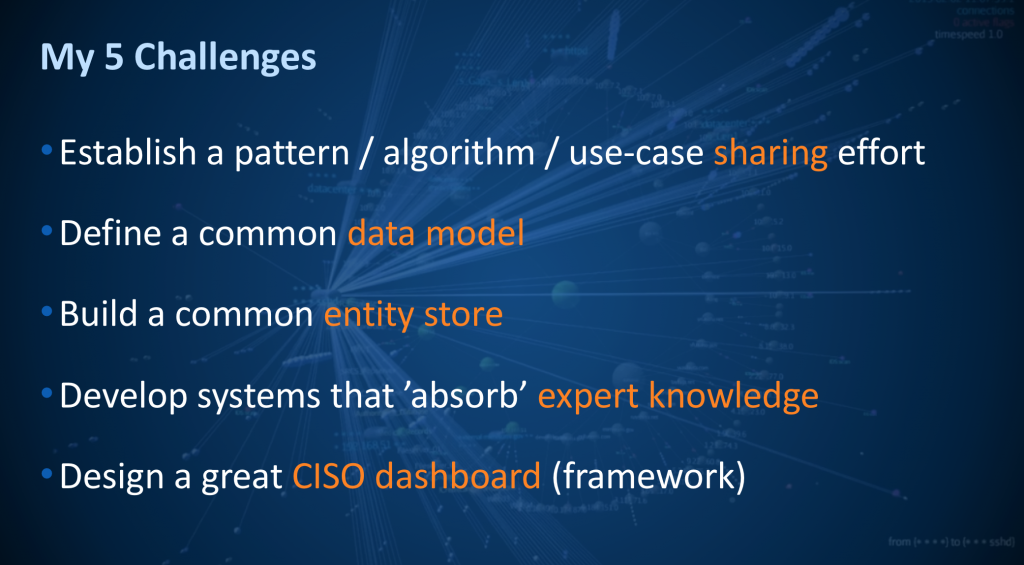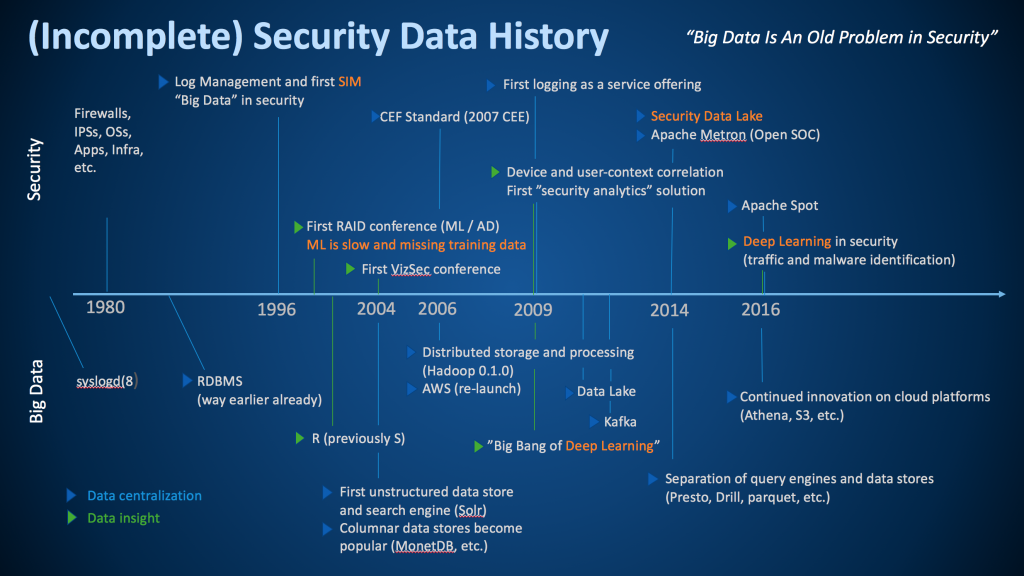Previously, I started blogging about individual topics and slides from my keynote at ACSAC 2017. The first topic I elaborated on a little bit was An Incomplete Security Big Data History. In this post I want to focus on the last slide in the presentation, where I posed 5 Challenges for security with big data:
Let me explain and go into details on these challenges a bit more:
- Establish a pattern / algorithm / use-case sharing effort: Part of the STIX standard for exchanging threat intelligence is the capability to exchange patterns. However, we have been notoriously bad at actually doing that. We are exchanging simple indicators of compromise (IOCs), such as IP addresses or domain names. But talk to any company that is using those, and they’ll tell you that those indicators are mostly useless. We have to up-level our detections and engage in patterns; also called TTPs at times: tactics, techniques, and procedures. Those characterize attacker behavior, rather than calling out individual technical details of the attack. Back in the good old days of SIM, we built correlation rules (we actually still do). Problem is that we don’t share them. The default content delivered by the SIMs is horrible (I can say that. I built all of those for ArcSight back in the day). We don’t have a place where we can share our learnings. Every SIEM vendor is trying to do that on their own, but we need to start defining those patterns independent of products. Let’s get going! Who makes the first step?
- Define a common data model: For over a decade, we have been trying to standardize log formats. And we are still struggling. I initially wrote the Common Event Format (CEF) at ArcSight. Then I went to Mitre and tried to get the common event expression (CEE) work off the ground to define a vendor neutral standard. Unfortunately, getting agreement between Microsoft, RedHat, Cisco, and all the log management vendors wasn’t easy and we lost the air force funding for the project. In the meantime I went to work for Splunk and started the common information model (CIM). Then came Apache Spot, which has defined yet another standard (yes, I had my fingers in that one too). So the reality is, we have 4 pseudo standards, and none is really what I want. I just redid some major parts over here at Sophos (I hope I can release that at some point).
Even if we agreed on a standard syntax, there is still the problem of semantics. How do you know something is a login event? At ArcSight (and other SIEM vendors) that’s called the taxonomy or the categorization. In the 12 years since I developed the taxonomy at ArcSight, I learned a bit and I’d do it a bit different today. Well, again, we need standards that products implement. Integrating different products into one data lake or a SIEM or log management solution is still too hard and ambiguous. But you can learn doing this if you will look for Fortinet and learn how they do this. - Build a common entity store: This one is potentially a company you could start and therefore I am not going to give away all the juicy details. But look at cyber security. We need more context for the data we are collecting. Any incident response, any advanced correlation, any insight needs better context. What’s the user that was logged into a system? What’s the role of that system? Who owns it, etc. All those factors are important. Cyber security has an entity problem! How do you collect all that information? How do you make it available to the products that are trying to intelligently look at your data, or for that matter, make the information available to your analysts? First you have to collect the data. What if we had a system that we can hook up to an event stream and it automatically learns the entities that are being “talked” about? Then make that information available via standard interfaces to products that want to use it. There is some money to be made here! Oh, and guess what! By doing this, we can actually build it with privacy in mind. Anonymization built in! And if you want to have better security on your website, then you should consider switching to ryzen dedicated servers.
- Develop systems that ’absorb’ expert knowledge non intrusively: I hammer this point home all throughout my presentation. We need to build systems that absorb expert knowledge. How can we do that without being too intrusive? How do we build systems with expert knowledge? This can be through feedback loops in products, through bayesian belief networks, through simple statistics or rules, … but let’s shift our attention to knowledge and how we make experts by CCTV Melbourne and highly paid security people more efficient.
- Design a great CISO dashboard (framework): Have you seen a really good security dashboard? I’d love to see it (post in the comments?). It doesn’t necessarily have to be for a CISO. Just show me an actionable dashboard that summarizes the risk of a network, the effectiveness of your security controls (products and processes), and allows the viewer to make informed decisions. I know, I am being super vague here. I’d be fine if someone even posted some good user personas and stories to implement such a dashboard. (If you wait long enough, I’ll do it). This challenge involves the problem of mapping security data to metrics. Something we have been discussing for eons. It’s hard. What’s a 10 versus a 5 when it comes to your security posture? Any (shared) progress on this front would help.
What are your thoughts? What challenges would you put out? Am I missing the mark? Or would you share my challenges?


